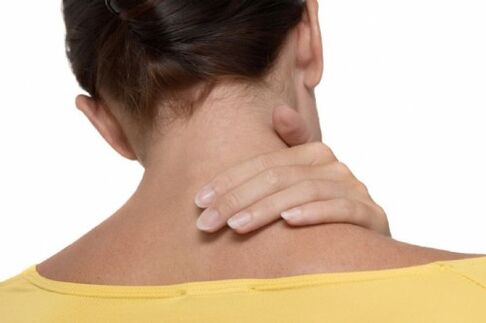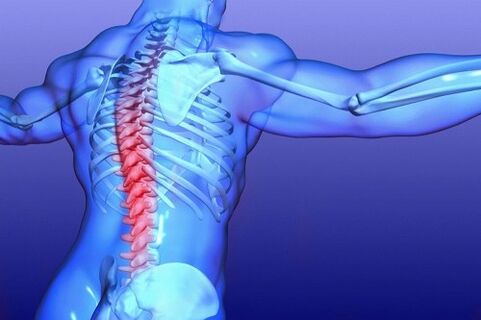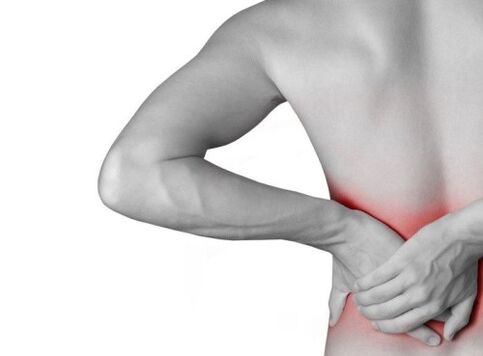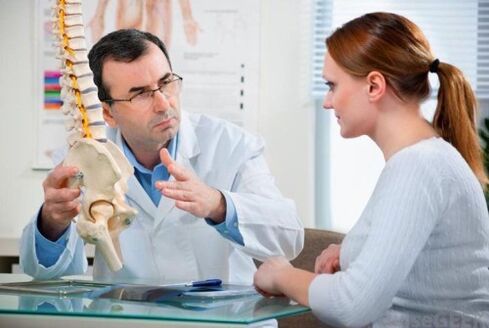Osteochondrosis forces the body to keep the muscles in the lumbar region tight, reducing the load on the spine. The patient seeks a more comfortable position and tries not to change it in order to relieve the discomfort.

main steps
The disease is progressive, therefore at different stages it has appropriate signs, the diagnosis of which will help the doctor prescribe the right treatment. Symptoms of lumbar osteochondrosis:
- at the first stage there is a pronounced discomfort and unremarkable pain in the lumbar spine;
- the second stage is accompanied by the destruction of the annulus fibrosus, which leads to the convergence of the vertebrae among themselves;
- this is followed by the formation of an intervertebral hernia and significant deformation of the spine, accompanied by severe pain;
- The fourth stage of osteochondrosis of the lumbar region leads to complete disability of patients: the destruction becomes more intense, is preceded by severe pain and difficulty moving.
The picture of the development and further treatment of osteochondrosis at each stage depends on the localization of the disease in a specific part of the lower back. Therapy is aimed at reducing pain, eliminating inflammation and normalizing the metabolic processes of the cartilage tissue of the intervertebral discs.
Osteochondrosis of the lumbar region is a dangerous degenerative disease of the spine, leading to degenerative processes. It is localized in the corresponding area and is characterized by ossification of the cartilage or destruction of the intervertebral discs of the crest. More than 80% of the course is accompanied by pain that radiates into the leg. Symptoms of pain are caused by pinching of the roots of the spinal nerves by overgrown tissue, medically known as lumboischialgia.

characters in the initial stages
Symptoms of lumbar osteochondrosis are accompanied by dull pain, which, as a rule, goes unnoticed. After moving weights and sudden movements, unpleasant sensations appear in the back or buttocks. The processes of initial degradation of the lumbar region begin.
The spinal ridge functions without any special changes, but the morphological processes of drowning of the cartilage tissue continue to progress, accompanied by the following signs:
- increase in the uncinate processes;
- minimal disc displacement with fibrous capsule rupture.
Clinical symptoms - sharp pain after physical exertion and prolonged (frequent) sitting in an uncomfortable position.
Sometimes the first stage is called preclinical, since lumbar osteochondrosis can practically not manifest itself.
Second floor
Symptoms of this stage are chronic pain radiating to the pelvic organs, buttocks or legs. Both relapses and remissions are characteristic. In principle, deterioration after physical exertion is observed.
Third section
Progressive processes lead to the formation of a hernia with all the ensuing consequences:
- neurological symptoms (dizziness, headache, fainting, tinnitus and loss of consciousness);
- problems with the kidneys and genitourinary system (uncontrolled urination);
- Problems with the cardiovascular system (arrhythmia).
At the third stage, in addition to drug methods and physical therapy, treatment may include surgery to avoid compression of the spinal cord and the development of undesirable complications.
fourth stage
The last stage is accompanied by calcification of the damaged intervertebral disc. The pains become much weaker, but the deformation of the spine continues. The body, activating the defense mechanism, starts the ossification processes, which leads to a decrease in the epidural space, increased compression of the spinal cord and disruption of the work of all systems controlled by it. Put simply, cartilage becomes bone and grows. It is from here that numerous dangerous symptoms characteristic of the third stage appear, but in a more acute form.
Prolonged complex treatment and surgical intervention are required.

How to distinguish where the lesion is located
Pinching certain nerve endings and segments has its own manifestations and symptoms of osteochondrosis:
- with damage to the roots of the spine L1, L2 - severe pain, numbness of the groin zone and inner thighs. The progression of osteochondrosis of the lower back, accompanied by a hernia, is characterized by lumboischialgia in both lower extremities;
- when localized in the lumbar region L5, a lancinating pain is characteristic when irradiating the thumb, decreased sensitivity;
- with numbness from the outer thigh to the lower leg and stabbing pain, the problem is pinching of the S1 nerve root.
Treatment is prescribed after diagnosis by MRI.
Symptoms of osteochondrosis of the lumbosacral region
The localization of the disease has a direct influence on the course and the symptoms. Degradation of the lumbar spine can cause myeloid lameness. The lower spinal cord has reduced blood flow, resulting in weakness in the legs when walking and frequent urination. After adequate rest, the symptoms disappear.
Ischemia of the cauda equina neurons is the main cause of intermittent caudogenic claudication:
- anemia of the peripheral parts of the legs;
- tingling and tingling when walking;
- over time, the symptoms rise from the legs to the groin of the genitals;
- Strength in the legs is restored after rest.
Lifting heavy objects in the presence of lumbar osteochondrosis can lead to pinching of the Adamkevich artery and complicate the course of spinal disease. There is paralysis - from mild to severe, incontinence of waste products, atrophy of muscle tissue, formation of bedsores.

Reasons contributing to the development of osteochondrosis
In most cases, it is believed that the development of osteochondrosis as a result of bipedalism occurs gradually, but additional provoking factors play an important role in the development of spinal diseases, among which are: physical inactivity, impaired metabolic processes, excess kilograms, lifting loads .
The complex interaction of unfavorable factors, the formation of a herniation (protrusion of the intervertebral disc) leads to a narrowing of the epidural space and pinching of the nerve roots.
Medical methods of dealing with the disease
Treatment of osteochondrosis of the lumbar spine at different stages is carried out after an accurate diagnosis of the location, stage and individual characteristics of the patient. The main methods are physiotherapy, reflex effects, drug support for pain relief and anti-inflammatory, herbal medicine. If treatment has proved ineffective or impossible without surgery due to neglect of the disease, surgical intervention is required.





















